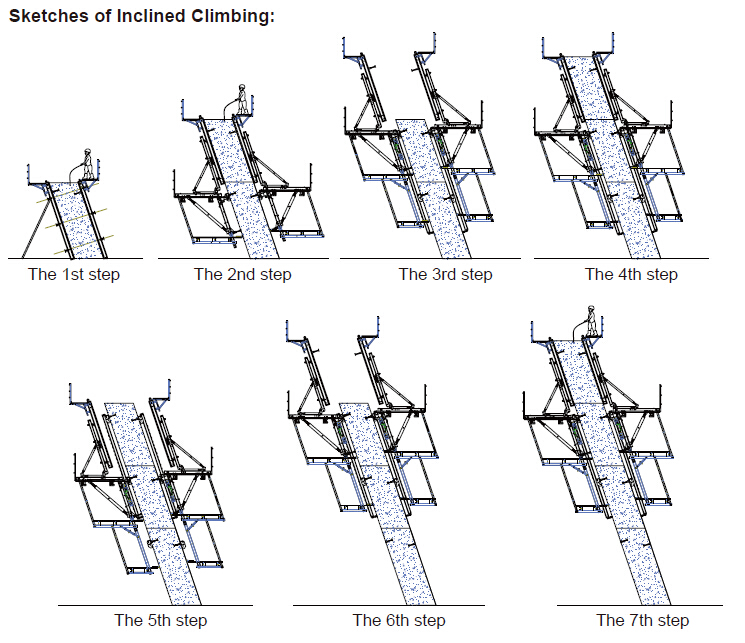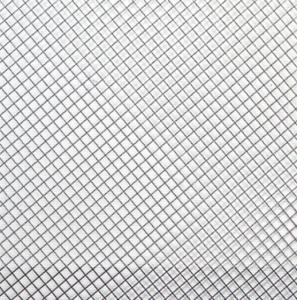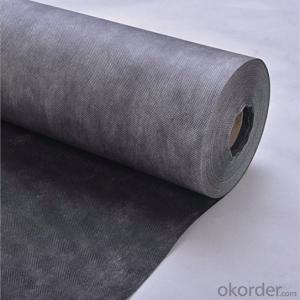Auto Climbing Bracket ACB100&ACB50 for formwork and scaffolding systems
- Loading Port:
- Tianjin
- Payment Terms:
- TT OR LC
- Min Order Qty:
- 50 m²
- Supply Capability:
- 1000 m²/month
OKorder Service Pledge
OKorder Financial Service
You Might Also Like
Auto-climbing Bracket ACB100 & ACB50
The power of the auto-climbing formwork is the hydraulic system, which includes the oil cylinder
and two commutators. The commutators can control the climbing of climbing rail and the bracket.
The steel rail and the bracket can inter-climbing, so the whole system will climb up steadily.
Cranes are not needed during the construction. It’s easy to operate, highly efficient and safe. It’s
the best choice for the construction of high buildings and bridges.
There are mainly two types of standard auto-climbing brackets, ACB-50 and ACB-100, the figure
means the push power of cylinder with unit of KN.
Characteristics:
◆ Perfect load bearing anchor system
Anchor system is the most important supporting part. The system is made of five parts shown
below. Thereinto, tensile bolt, V-climbing cone and washer can be taken out for reusing after the
concrete pouring finished.There are two kinds of anchor systems,A & B. A is matched with single
anchor shoe and B is matched with double anchor shoe.
◆ Crane-independent
Crane-independent forming, striking and climbing speeds up the work procedures on the
construction site and also makes them independent of each other. This means the planned
sequences can be maintained along with guaranteeing high productivity levels. The crane can
therefore be used for other tasks.
Hydraulic system is mainly made of two commutators,
oil cylinder and power distribution system.The
commutators can control the climbing of climbing rail
and bracket.
◆ High bearing capacity and safe
The stable working platforms are able to carry large loads, e.g. the storage of reinforcing steel
for the next climbing section. Generously-sized working platforms, the well thought-out design for
handling very high wind loads and the patented control function of the climbing mechanism are
some of the special details contained within the comprehensive safety concept.
◆ Platforms adjusted to suit the angle of inclination
The horizontal working areas thus created provide safe and comfortable conditions for
reinforcement work, shuttering and striking, concreting and finishing.
◆ The ACB formwork system can climb not only vertically but also slantways, the largest angle is
18 degrees.
◆ The system can climb up wholly or separately. The climbing process is steady, synchronous
and safe.
◆ The bracket will not fall to the ground until the construction is finished, the field will be saved
and the impacting breakage will be reduced (especially the panel).
◆ The system will furnish omnidirectional platform, the construction organizations don’t need to
set up additional operation platform.
◆ The error of structure construction is small and easy to correct.
◆ The climbing speed is fast, the construction course will be quickened.
◆ The formwork can climb itself and cleaning work can be done in the same situs , the used times
of tower crane will be greatly reduced.

- Q:What is the difference between the steel template and the wood template? When to use steel formwork? When to use a wooden template?Now what kind of use
- Can use a combination of steel templates can also be used in large format steel formwork
- Q:What is the lifespan of steel formwork?
- The lifespan of steel formwork can vary depending on various factors such as the quality of the steel, maintenance practices, and frequency of use. However, with proper care and maintenance, steel formwork can last for many years, potentially even decades.
- Q:What are the typical fire resistance ratings of steel formwork systems?
- The typical fire resistance ratings of steel formwork systems can vary depending on various factors such as the specific design, material thickness, and fire protection measures in place. However, steel formwork systems generally have fire resistance ratings ranging from 30 minutes to 120 minutes, providing adequate protection in case of fire incidents.
- Q:How is steel formwork manufactured?
- Steel formwork is manufactured by cutting and shaping steel plates and bars according to the required dimensions and designs. These steel components are then welded together to form the desired formwork panels, beams, and columns. The steel formwork is further reinforced with additional steel bars and mesh, and the surfaces are treated to resist corrosion. Finally, the formwork is assembled and prepared for use in construction projects.
- Q:Can steel formwork be used in areas with limited construction space or tight site constraints?
- Yes, steel formwork can be used in areas with limited construction space or tight site constraints. Steel formwork is known for its versatility and adaptability, making it suitable for various construction projects, including those with limited space. One of the main advantages of using steel formwork in these situations is its strength and durability. Steel formwork can withstand high pressure and heavy loads, allowing it to be used in confined areas without compromising its structural integrity. This makes it an ideal choice for areas with limited construction space or tight site constraints. Furthermore, steel formwork is highly flexible and can be easily adjusted or modified to fit the available space. It can be customized to different shapes and sizes, allowing it to be used in complex or irregularly shaped areas. This adaptability makes steel formwork a practical solution for construction projects with limited space. In addition, steel formwork is reusable and can be dismantled and reassembled in different locations. This feature is particularly useful in areas with tight site constraints, as it allows the formwork to be easily moved and reused in different parts of the construction site. This not only saves time and effort but also reduces the need for additional formwork materials. Overall, steel formwork is a suitable choice for areas with limited construction space or tight site constraints. Its strength, adaptability, and reusability make it a practical solution for various construction projects, ensuring efficient and effective use of the available space.
- Q:How does steel formwork affect the overall efficiency of the construction process?
- Steel formwork can greatly enhance the overall efficiency of the construction process. This is primarily due to its durability, versatility, and ease of use. Firstly, steel formwork is incredibly strong and can withstand the weight and pressure of concrete without bending or warping. This allows for faster construction as there is no need to wait for the formwork to be repaired or replaced. Additionally, steel formwork can be reused multiple times, reducing the time and cost associated with constantly purchasing new formwork materials. Moreover, steel formwork is highly versatile and can be easily customized to meet the specific requirements of different construction projects. It can be easily adjusted, cut, and welded to create various shapes and sizes, allowing for greater design flexibility. This flexibility also enables faster construction, as the formwork can be quickly modified to accommodate changes in the construction plans. Furthermore, steel formwork is designed to be user-friendly, making it easier and faster for construction workers to assemble and dismantle. It is lightweight compared to other materials like wood or aluminum, reducing the physical effort required during installation and removal. The standardized components of steel formwork also make the assembly process more efficient and less time-consuming. In addition, steel formwork offers improved quality control and accuracy in construction. The smooth surface of steel formwork ensures a consistent finish on the concrete structures, reducing the need for additional finishing work. This not only saves time but also enhances the overall aesthetics of the construction project. Overall, the use of steel formwork significantly improves the efficiency of the construction process by reducing construction time, minimizing material waste, and enhancing the quality and accuracy of the final structures. Its durability, versatility, and ease of use make it an ideal choice for both large-scale and small-scale construction projects.
- Q:What are the common accessories used with steel formwork?
- Common accessories used with steel formwork include form ties, formwork clamps, scaffolding, adjustable steel props, and formwork braces.
- Q:What are the considerations when designing steel formwork for architectural facades?
- When it comes to designing steel formwork for architectural facades, there are several crucial factors to consider: 1. Structural integrity is of utmost importance. The formwork must be able to bear the weight of the concrete and any additional loads, such as wind or seismic forces, without any deformation or failure that could compromise the structure's safety. 2. Aesthetic requirements play a significant role. Architectural facades often have intricate and unique designs. It is essential for the formwork to accurately replicate these designs, ensuring that the final concrete surface meets the desired aesthetic standards. This may involve using custom-made formwork or incorporating architectural features into the formwork itself. 3. Assembly and disassembly should be easy. The formwork should be designed in a way that allows for quick and effortless assembly and disassembly. This is crucial for construction efficiency and future reuse. The design should enable simple connections between formwork elements, minimizing time and effort during assembly. 4. Reusability is a key consideration. Steel formwork is often designed to be reusable, reducing construction costs and environmental impact. It is important to ensure that the formwork can withstand multiple uses without significant deterioration or loss of performance. 5. Durability is vital. The formwork must be able to withstand the harsh conditions of construction sites, including exposure to weather, chemicals, and rough handling. The choice of materials and protective coatings should be made to maintain the formwork's structural integrity and functionality throughout its lifespan. 6. Safety is paramount. The design of the steel formwork should prioritize the safety of workers during assembly, disassembly, and concrete pouring. Features like guardrails, access platforms, and secure connections should be incorporated to ensure worker safety. 7. Cost-effectiveness should be considered. The formwork design should aim to achieve the desired architectural aesthetics while also being cost-effective. This may involve optimizing the design to minimize the amount of steel required or exploring alternative formwork materials when appropriate. In conclusion, designing steel formwork for architectural facades requires careful consideration of structural integrity, aesthetics, ease of assembly, reusability, durability, safety, and cost-effectiveness. By taking these factors into account, designers can create formwork that meets project requirements while ensuring efficiency and quality in construction.
- Q:What are the common safety certifications required for steel formwork?
- To ensure the utmost safety on construction sites, steel formwork often necessitates various safety certifications. These certifications encompass the following: 1. OSHA Certification: The steel formwork must possess the Occupational Safety and Health Administration (OSHA) certification. This certification guarantees compliance with OSHA's safety standards, encompassing fall protection, proper scaffolding, and other safety measures. 2. ANSI Certification: Another indispensable requirement is the American National Standards Institute (ANSI) certification for steel formwork. ANSI establishes standards for diverse aspects of construction safety, including materials, equipment, and worker protection. An ANSI certification confirms conformity with these standards. 3. CSA Certification: When employing steel formwork in Canada, the Canadian Standards Association (CSA) certification is usually obligatory. This certification ensures compliance with CSA's safety standards, encompassing design, materials, and structural integrity. 4. CE Marking: The CE marking is an imperative certification for steel formwork employed in the European Union and other countries adhering to European standards. It signifies adherence to the European Union's essential health, safety, and environmental protection requirements. 5. ISO Certification: Although not directly related to safety, an ISO certification signifies that the manufacturer of the steel formwork has implemented a quality management system conforming to the International Organization for Standardization (ISO) standards. This certification guarantees consistent production of the formwork, meeting specific quality requirements. It is crucial to acknowledge that the precise certifications required for steel formwork may vary depending on the country, region, or project specifications. Consequently, consulting local regulations and project specifications is essential to determine the exact certifications necessary for steel formwork in a specific context.
- Q:How does steel formwork handle surface imperfections in concrete?
- Steel formwork is a rigid and durable material that is able to handle surface imperfections in concrete effectively. Its strength and stability allow it to support the weight of wet concrete, preventing any deformation or distortion caused by uneven surfaces. Additionally, steel formwork provides a smooth and uniform surface, minimizing any irregularities or blemishes that may occur during the pouring and curing process of concrete. Overall, steel formwork offers excellent resistance to surface imperfections, resulting in high-quality and aesthetically pleasing concrete finishes.
1. Manufacturer Overview |
|
|---|---|
| Location | |
| Year Established | |
| Annual Output Value | |
| Main Markets | |
| Company Certifications | |
2. Manufacturer Certificates |
|
|---|---|
| a) Certification Name | |
| Range | |
| Reference | |
| Validity Period | |
3. Manufacturer Capability |
|
|---|---|
| a)Trade Capacity | |
| Nearest Port | |
| Export Percentage | |
| No.of Employees in Trade Department | |
| Language Spoken: | |
| b)Factory Information | |
| Factory Size: | |
| No. of Production Lines | |
| Contract Manufacturing | |
| Product Price Range | |
Send your message to us
Auto Climbing Bracket ACB100&ACB50 for formwork and scaffolding systems
- Loading Port:
- Tianjin
- Payment Terms:
- TT OR LC
- Min Order Qty:
- 50 m²
- Supply Capability:
- 1000 m²/month
OKorder Service Pledge
OKorder Financial Service
Similar products
New products
Hot products
Hot Searches
























